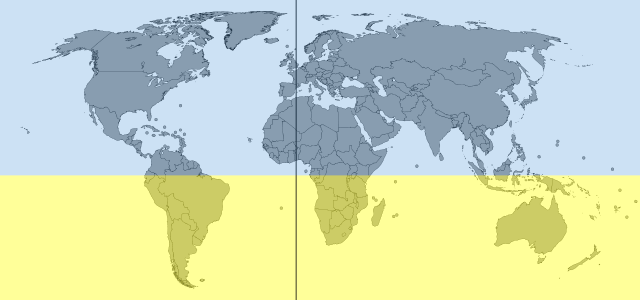Image credit: DLommes, CC BY-SA 3.0, via Wikimedia Commons
All around the Globe people look up at night to gaze at the stars, planets, the Moon and other celestial wonders. But we all see the night sky differently depending on many things, such as where exactly on Earth we are, what time of the year it is and how dark the sky is in our location.
Observing from a dark countryside, for example, as opposed to a light-polluted city, can make all the difference between seeing just a handful of shiny dots and a sky glittering with several thousands of stars. And we all know that different constellations show up in the sky at different seasons.
But the most dramatic difference in the appearance of the night sky has to do with the observer’s latitude, i.e. how far North or South of the Equator you are.
We asked our portable planetarium visitors how exactly they thought the sky was different when viewed from the Northern and Southern Hemispheres. Below are the most popular answers we received! Let’s have a look…
You cannot see the North Star from the Southern Hemisphere
True! The North Star, the one that marks the position of the North Celestial Pole, is only visible to the Northern Hemisphere observers. Moreover, the constellations that are close to the North Star – we call them circumpolar constellations [as they circle around the North Star and stay up in the sky all the time, all year round] can also be only seen from the Northern Hemisphere. The Northern Hemisphere’s circumpolar constellation include Ursa Major, Ursa Minor, Cepheus and Cassiopeia.
The Southern Hemisphere, on the other hand, does not have its own ‘Southern Star’. But it does have a number of circumpolar constellations that are unique to that part of the world. They include Carina, Crux and Centaurus, the constellations many Northern Hemisphere stargazers have never even heard of!
You can see the Milky Way
The brightest part of the Milky Way, its core, lies in the constellation Sagittarius the Archer. Sagittarius is a Southern Sky constellation and the Southern Hemisphere observers can see it directly overhead in the Winter. Sadly, Sagittarius never rises high in the Northern Hemisphere’s skies. So indeed, the stargazers ‘down South’ do enjoy a better view of the galactic centre. But don’t despair! You can spot the Milky Way from the Northern Hemisphere too! It appears above the Southern Horizon in the late Summer and looks absolutely stunning! To find the Milky Way from ‘up North’, wait for the night of the New Moon, go to a dark location and look South! Good luck!
Cool fact: The Milky Way is not the only galaxy you can observe from the Southern Hemisphere. The Milky Way’s two satellite galaxies, the Large Magellanic Cloud and the Small Magellanic Cloud, can be easily spotted in the Southern Skies too. Strictly speaking, you can see them North of the Equator up to a latitude of 15 degrees North – though they appear low above the horizon.
They have different constellations
The constellations located close to the North or South Celestial Pole can only be seen from their respective Hemisphere. Other constellations can be spotted from both Hemispheres, although their exact orientation and how high they appear in the sky depends on the observer’s latitude.
The moon’s upside down and the phases are opposite
The first and the last quarter Moon phases look the opposite when viewed from the Northern and Southern Hemispheres. From the Northern Hemisphere the first quarter Moon looks like a ‘D’ and the last quarter looks like a ‘C’. The sunlit portion of the lunar surface moves right to left. The Southern Hemisphere observers see the exact opposite. That is the first quarter Moon looks like a ‘C’ and the last quarter Moon looks like a ‘D’. The sunlit part of the lunar surface moves left to right!
Even the oh-so-familiar Full Moon looks the wrong way up when you see it from the opposite hemisphere! So confusing, right?
The constellations are tilted or even flipped upside down
Indeed, many familiar Northern Sky constellations appear upside down and flipped left-to-right when viewed from the Southern Hemisphere.
For example, if you are South of the Equator, the Northern Hemisphere’s most recognizable winter constellation Orion the Hunter, will be standing on its head and the supergiant Betelgeuse will mark the lower right part of Orion’s hourglass shape.
Which Hemisphere do you look at the sky from? What are your favourite stars and constellations? Let us know in the comments below!
Author: Irina Vladimirova
Irina Vladimorova is a presenter at WonderDome Planetarium and a regular contributor to WonderDome Astronomy Blog. She holds a degree in Astrophysics and a special place in her heart for planetary science.

